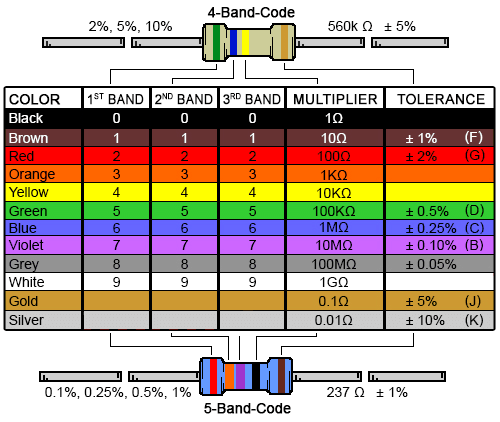
If you’ve ever had to figure out a resistor color code–the value, tolerance, and wattage of multiple resistors, you know how mentally exhausting it can become. Mnemonic devices aside, sometimes it’s simpler to have a visual guide to help.
This tool is designed to decode color-banded axial lead resistors with four or five bands. You can use the number of bands and the colors along with the charts below to determine the value and tolerance of the resistors.
Feel free to make use of our favorite Resistor Color Code Guide, available below. Right-click for a higher-definition view.

How to Read Resistor Color Code
Four banded resistors have two bands for resistance, one multiplier band, and one band for tolerance. Five band resistors have an extra color band added to the first and second resistance digits. This gives you a more precise reading. Everything else shifts to the right, so the fourth band becomes the multiplier and the fifth becomes the tolerance.
Super simple, right?
Also, remember to take a good look at the body of your larger resistors to see what information is available to you. Many resistors are marked with their resistance value, tolerance, and wattage resistance if their body is large enough.
British Standard Code
Larger power resistors may use BS1852 British Standard Code, which uses suffix letters to replace part of the number to minimize misreading the position of the decimal point. This system uses “K for thousands or kiloohms and the letter M for millions or megaohms. R is used to denote a decimal point for resistor values of less than one. Thus:
- 0.01Ω = R010 or 0R01
- 1.0Ω=1R0
- 24.9Ω=24R9
- 4.7KΩ = 4K7
- 470KΩ = 470K or 0M47
- 1MΩ = 1M0
Tolerance Letters
Tolerance letters take the place of written out percentages. Tolerances also use K and M, so be sure when reading the code to know which letter refers to resistance value and which to tolerance.
- B = 0.1%
- C = 0.25%
- D = 0.5%
- F = 1%
- G = 2%
- J = 5%
- K = 10%
- M = 20%
Finally, remember the first band is typically the one closest to a lead, while the tolerance, which is always gold or silver, is the last band. This will help you understand which way to “read” the bands.
Carbon resistors are the most common type of resistor used within electronics. Carbon resistor color code is the standard resistor color code shown on this page.
And if there’s ever any doubt, you can measure resistance with a multi-meter.
Answers to a few commonly asked questions about resistors
What are the different types of electrical resistors?
- Wire Wound Resistor–constantan or manganin wire wound around an insulating cylinder.
- Metal Film Resistor–carbon or metal deposited as a thin film on to an insulating core.
- Carbon Composition Resistor–mainly made of carbon clay covered with a plastic case. Very temperature sensitive.
- Carbon Film Resistor
- Variable Resistor–resistance value can be adjusted. A rheostat is one example.
- Varistor–non-linear component where resistance changes with applied voltage.
- Thermistor–resistance value changes with a change in temperature
- Light Dependent Resistor–resistance varies depending on intensity of light.
Does a resistor consume energy?
Yes. As they do their primary job (control the flow of energy) they also consume some of the energy. A good example of this is the filament of a traditional light bulb, which lights up because it resists the flow of energy moving through it. But it also puts out heat (as anyone who has tried to change a burning light bulb can attest.)
Do resistors have polarity?
Current flows from positive to negative according to current direction. So resistors on their own do not have polarity in the sense they can connect to a circuit in either direction. But current can only flow in a single direction.

You must be logged in to post a comment.